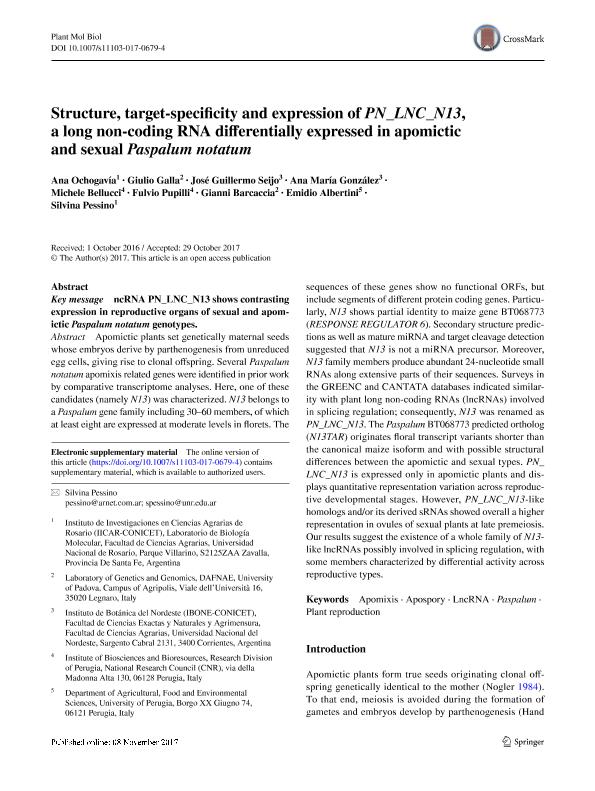Artículo
Structure, target-specificity and expression of PN_LNC_N13, a long non-coding RNA differentially expressed in apomictic and sexual Paspalum notatum
Ochogavía, Ana Claudia ; Galla, Giulio; Seijo, José Guillermo
; Galla, Giulio; Seijo, José Guillermo ; González, Ana María
; González, Ana María ; Bellucci, Michele; Pupilli, Fulvio; Barcaccia, Gianni; Albertini, Emidio; Pessino, Silvina Claudia
; Bellucci, Michele; Pupilli, Fulvio; Barcaccia, Gianni; Albertini, Emidio; Pessino, Silvina Claudia
 ; Galla, Giulio; Seijo, José Guillermo
; Galla, Giulio; Seijo, José Guillermo ; González, Ana María
; González, Ana María ; Bellucci, Michele; Pupilli, Fulvio; Barcaccia, Gianni; Albertini, Emidio; Pessino, Silvina Claudia
; Bellucci, Michele; Pupilli, Fulvio; Barcaccia, Gianni; Albertini, Emidio; Pessino, Silvina Claudia
Fecha de publicación:
11/2017
Editorial:
Springer
Revista:
Plant Molecular Biology
ISSN:
0167-4412
e-ISSN:
1573-5028
Idioma:
Inglés
Tipo de recurso:
Artículo publicado
Clasificación temática:
Resumen
Key message: ncRNA PN_LNC_N13 shows contrasting expression in reproductive organs of sexual and apomictic Paspalum notatum genotypes. Abstract: Apomictic plants set genetically maternal seeds whose embryos derive by parthenogenesis from unreduced egg cells, giving rise to clonal offspring. Several Paspalum notatum apomixis related genes were identified in prior work by comparative transcriptome analyses. Here, one of these candidates (namely N13) was characterized. N13 belongs to a Paspalum gene family including 30–60 members, of which at least eight are expressed at moderate levels in florets. The sequences of these genes show no functional ORFs, but include segments of different protein coding genes. Particularly, N13 shows partial identity to maize gene BT068773 (RESPONSE REGULATOR 6). Secondary structure predictions as well as mature miRNA and target cleavage detection suggested that N13 is not a miRNA precursor. Moreover, N13 family members produce abundant 24-nucleotide small RNAs along extensive parts of their sequences. Surveys in the GREENC and CANTATA databases indicated similarity with plant long non-coding RNAs (lncRNAs) involved in splicing regulation; consequently, N13 was renamed as PN_LNC_N13. The Paspalum BT068773 predicted ortholog (N13TAR) originates floral transcript variants shorter than the canonical maize isoform and with possible structural differences between the apomictic and sexual types. PN_LNC_N13 is expressed only in apomictic plants and displays quantitative representation variation across reproductive developmental stages. However, PN_LNC_N13-like homologs and/or its derived sRNAs showed overall a higher representation in ovules of sexual plants at late premeiosis. Our results suggest the existence of a whole family of N13-like lncRNAs possibly involved in splicing regulation, with some members characterized by differential activity across reproductive types.
Palabras clave:
APOMIXIS
,
APOSPORY
,
LNCRNA
,
PASPALUM
,
PLANT REPRODUCTION
Archivos asociados
Licencia
Identificadores
Colecciones
Articulos(IBONE)
Articulos de INST.DE BOTANICA DEL NORDESTE (I)
Articulos de INST.DE BOTANICA DEL NORDESTE (I)
Citación
Ochogavía, Ana Claudia; Galla, Giulio; Seijo, José Guillermo; González, Ana María; Bellucci, Michele; et al.; Structure, target-specificity and expression of PN_LNC_N13, a long non-coding RNA differentially expressed in apomictic and sexual Paspalum notatum; Springer; Plant Molecular Biology; 96; 1-2; 11-2017; 53-67
Compartir
Altmétricas



